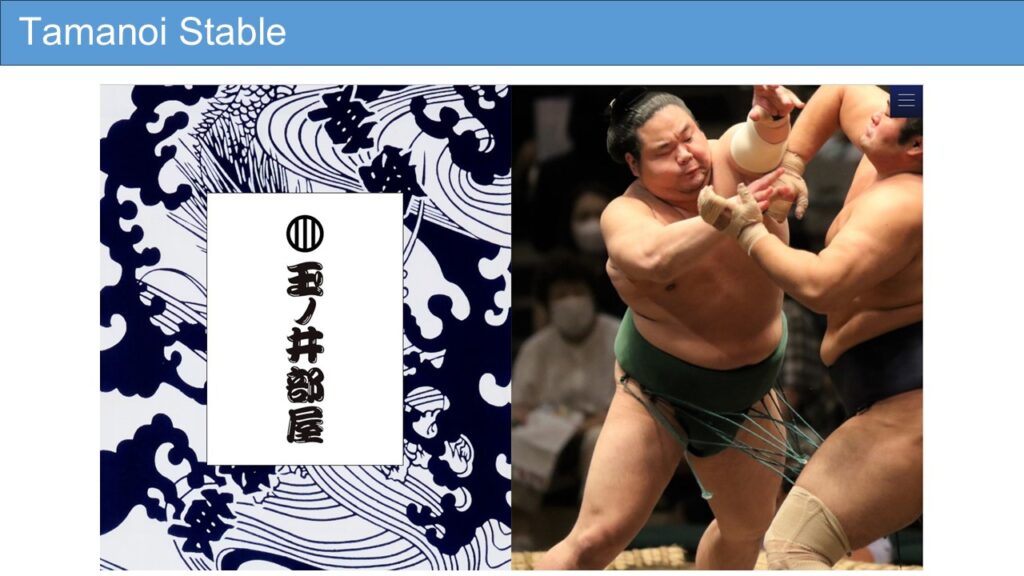
Sumo is a traditional Japanese martial art that was established in 726, when two sumo athletes or Rikishi, Nomi no Sukune and Taima no Hayate, competed in front of the Shomu emperor, who ordered all shrines in Japan to hold Sumo events to pray for good harvests of the year. At the match, Nomi no Sukune won, and he was enshrined in Nomi no Sukune Shrine as the deity of Sumo. Now, the Sumo Association holds the ritual ceremony before the Tokyo Grand Sumo Tournaments in January, May, and September at Nomi no Sukune Shrine. Newly appointed Yokozuna, a top-ranked Rikishi, also performs the Dohyo Iri ceremony.
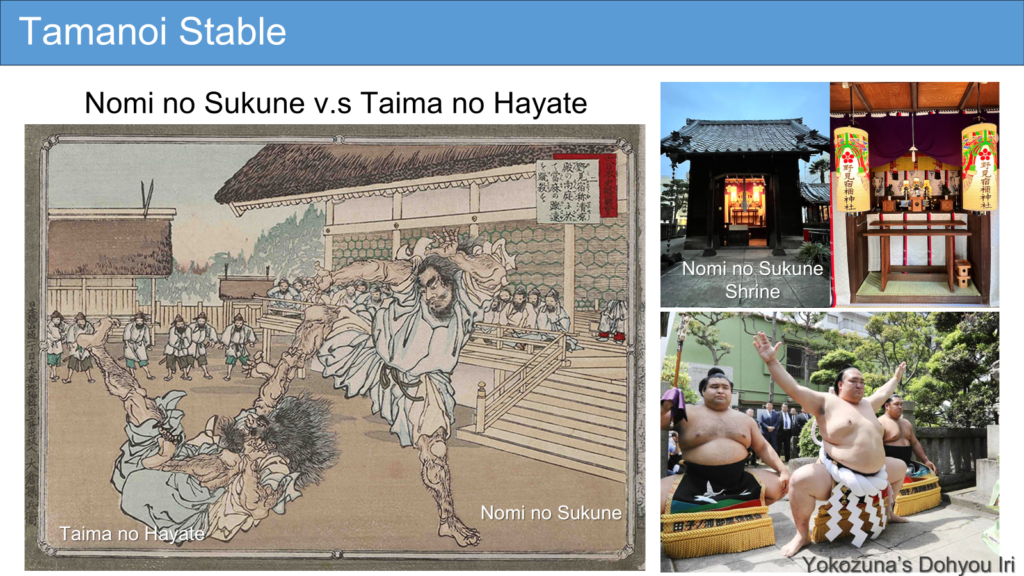
Nowadays, English speakers call Rikishi a Sumo wrestler, but they are not athletes or wrestlers. They were samurai who served their lord with tremendous power and fighting skills. The word “shi” in Rikish means samurai, like Bushi, which is another name for samurai in Japanese. Literally, Riki means power, so Rikishi means the powerful samurai. Rikishi also pays great respect to Japanese deities, so there are still a lot of religious ceremonies and ritual events in the sumo world.
Today, we visited Tamanoi Stable in Tokyo’s northern area. It is one of the 46 sumo stables in the Tokyo area, led by Tamanoi Oyakata, a stable master who was a former Ozaki Tochi Azuma (the 2nd generation).
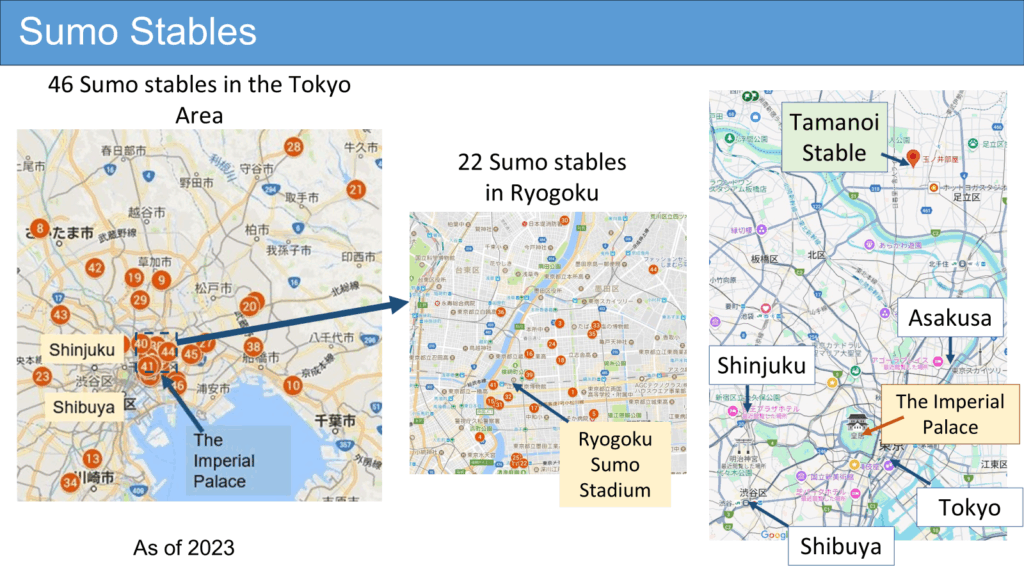
Ozeki is a title of Rikishi and is ranked second highest (the top is Yokozuna). He won in all six categories in the Grand Sumo Tournaments and was promoted to the major class in 1996. Eventually, he won three times in the top category of the Grand Sumo Tournaments. In 2007, he retired due to a brain injury and inherited the Tamanoi Stable from his father, the former Tamanoi Oyakata. He is now training 19 Rikishis, two in the major class, Sekitori, and 17 in the minor class.
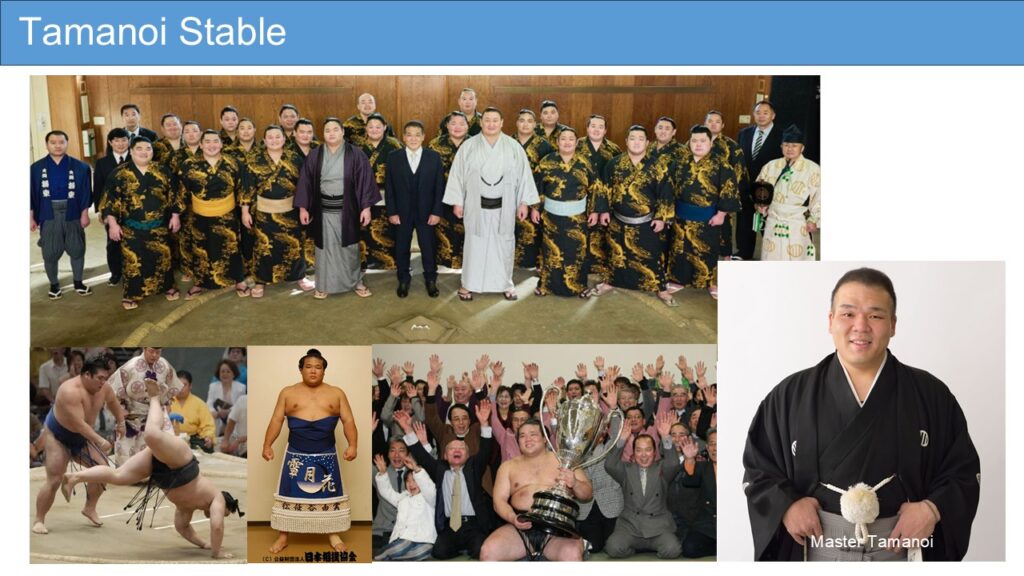
The sumo world is highly hierarchical. Only Sekitori, which is Juryo or higher, is regarded as a professional Rikishi. Rikishis lower than Juryo are trainees who cannot earn any fight money and only receive an allowance from the Sumo Association. Oyakata, a master of the stable, must take care of them, providing them with space for sleep, necessary clothes, and a vast amount of meals twice a day. The association supports the stables according to the number of Sekitori and their ranks. If the stable has Yokozuna, it has enough funds to get more young Rikishis and raise them to higher ranks. However, the total number of Yokozuna and Ozeki is limited to eight at maximum, so other stables without Yokozuna and Ozeki need support from fans. The stables have their own supportive club called Koenkai. The Koenkai members pay an annual membership fee to the stable and get some privileges, such as being free to watch the morning training at any time, joining the party after the tournament, and being invited to any events organized by the stable. I am also a member of Koenakai of Tamanoi Stable and enjoy watching the morning training and chatting with Rikishis at the party.

The hierarchy is even more significant when it comes to their income. There is a big difference between Sekitori and lower. Once Makushita in the minor class is promoted to the Juryo, the second highest rank in the major class, he will earn more than ten times higher than the previous position. Only Rikishis in the major class are allowed to get married and live in their own houses. Lower-ranked Rikishis must stay in the stable, and their private space in the large room is only about 1.8 square meters or 19.6 square feet.
The regular income of Yokozuna, about USD 240,000, may not seem lucrative compared with other major sports such as baseball, basketball, and football. However, Rikishi has another source: winning rewards offered by business entities. When you watch the sumo matches of the tournaments, you can see the many flags marched along the ring before the game. Companies pay 70,000 yen or USD 446 per flag to the association to put their company or product name on it, which works as an effective advertisement because the grand tournament matches are so popular among the Japanese that all games are broadcast nationwide for consecutive15 days. After the commission fee and expenses are redacted, 30,000 yen per flag goes to the winner of the game. In particular, Yokozuna’s matches are popular, so it is not exceptional that twenty or more flags circle along the ring. If Yokozuna won all 15 matches with 20 flags a match, he would get another 9,000,000 yen or about USD 57,000 at one tournament. Usually, Yokozuna wins more than ten matches, and there are six tournaments a year. This means that a Yokozuna might earn rewards of 90,000,000 yen or approx. USD 570,000 a year on average, which makes his annual income more than 130 million yen or approx. USD 830,000 or more. Also, there are victory rewards when Rikishi wins the tournament title, which is 2.82 million yen for Yokozuna, 2.35 million yen for Ozeki, 1.69 million yen for Sekiwake and Komusubi, 1.31 million yen for Makuuchi Rikishi, or 1.04 million yen for Juryo.
An ancient citizen sarcastically remarked that Yokozuna’s job is easy because he would earn considerable money by working only 90 days a year.
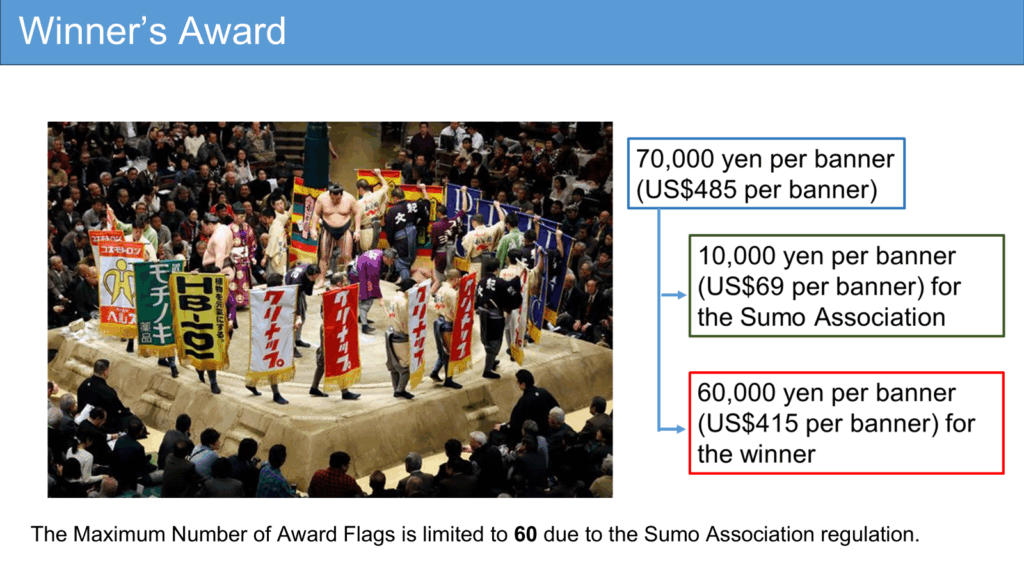
The sumo match is performed on the ring called Dohyo, which is 4.55 meters in diameter. Two Rikishis crouch behind the Shikiri (face-off line) and then fight. The rikishi who is pushed out of the Dohyo or whose parts of his body, except for his foot, touch the ground loses the game.

If you still don’t have a clear idea or image of what a sumo match involves, please check out the following video, showcasing one of the best matches from the final day of the May Grand Tournament 2025.
This slide shows a typical day for Rikishi. The minor class gets up at 6:00 a.m. to prepare for the morning training, and they start their own training around 7:00 a.m. Around 8:00, the Rikishi in the major class shows up and joins the training. Then, intensive training starts and continues until around 11:00. After the training, the minor Rikishi cleans the training place while the majors take a bath. Brunch or Chanko, the stable’s meal, is served at 11:30. After the Chanko, all Rikishis, especially young ones, have an important task: taking a nap to gain weight and become heavy. They have free time after brunch, but young ones usually exercise resistance to strengthen their bodies.
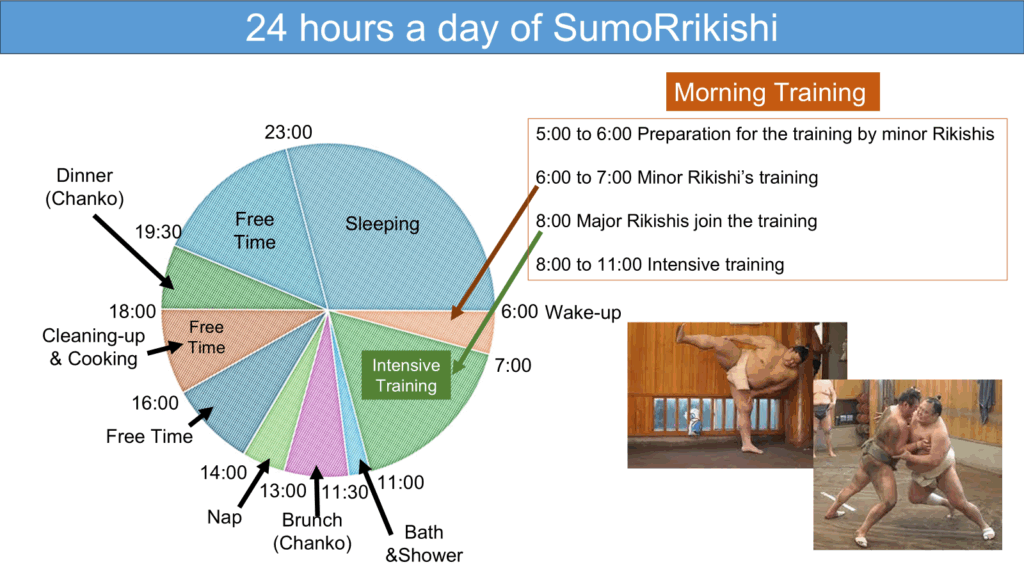
Roughly, the sumo morning training has two sessions. The first one involves three essential pieces of training for their bodybuilding and making their body lithe. Shiko and Suriashi build strong and resilient muscles in their lower body, which is vital to push their opponent out of the ring. Shiko is amazing. Rikishi raises one leg high and supports his heavy weight on another leg, puts it down slowly, and lowers his hip as low as possible, similar to a deep squat exercise. Suriashi is one of the basic and essential movements to push his opponent effectively. Matawari works to make their body lithe to prevent any injuries. I was surprised that a heavy-fat Rikishi showed flexibility like a gymnast.

The second session includes intensive training: Sanban-Keiko, Moushiai-Keiko, and Butsukari-Keiko. It usually starts with Sanban-Keiko, a training match between rikishis from the same or neighboring categories. Sanban means three games, so it will be played three times in a row, but usually, it will be played more than three times until the player is satisfied with their performance or until the master stops playing. The next is Moushiai-Keiko. It’s another training match. However, this time, all rikishis can participate. The winner of the game stays on the Dohyo while the loser steps off. Then, the winner chooses the next among the Rikishis who are waiting for their chance in Moushiai-Keiko, raising their hands or even stepping forward just before the winner to show their eagerness. As you can imagine, the high-ranked Rikishi can usually win the first and second training matches. Still, in the third match or more, the winner gets tired and has difficulty pushing the opponent out of the Dohyo. It can be said the ideal training for both high-ranked and lower-ranked Rikishis because the former can improve his endurance to fight 15 matches in a row during the grand tournament, and the latter has a chance to fight the stronger Rikishi to brush up their skills and increase pushing power.
The final segment is Butsukari-Keiko. The lower-ranked Rikishi pushes the higher-ranked Rikishi from the edge of the Dohyo to the other end many times, and this continues until the lower-ranked Rikishi can no longer push again. It seems that the higher-ranked Rikishi helps and supports the lower-ranked Rikishis’ training, but it also helps him build a strong body trunk and legs.
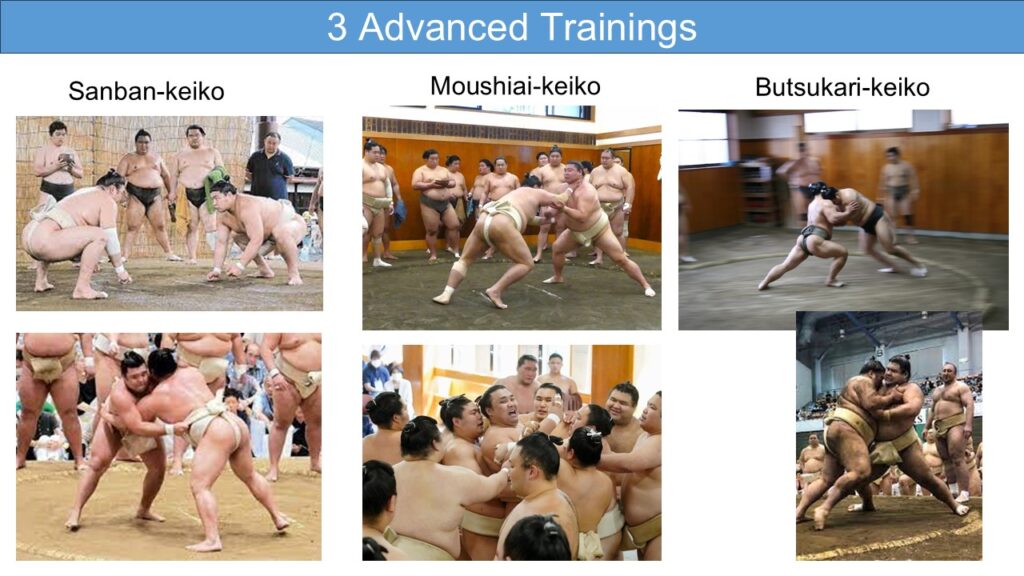
At the end of the morning training, all Rikishis pray for the deity of Sumo before cleaning the Dohyo. They put a holy pole back in the center of the Dohyo, where the deity comes back and resides.
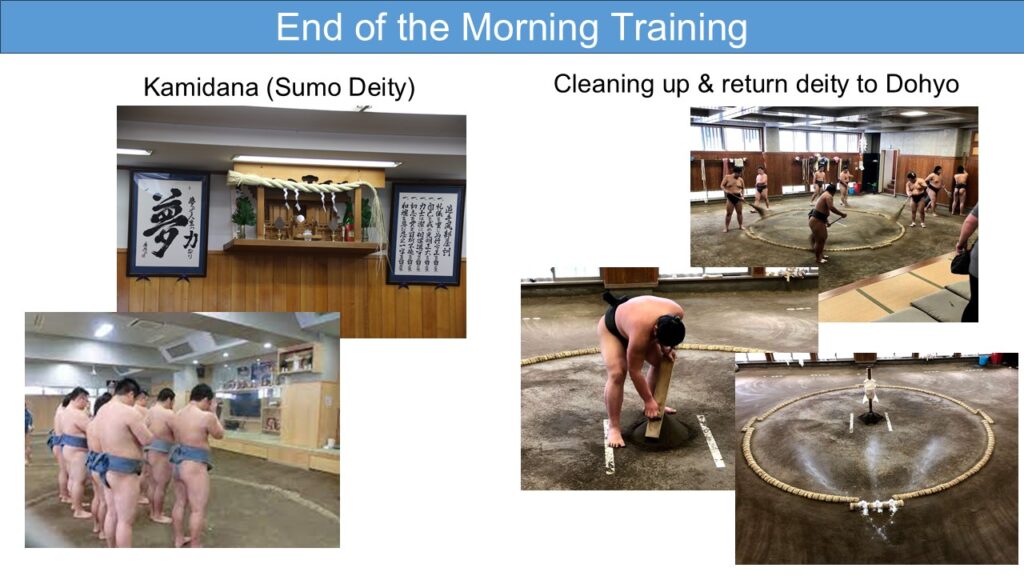
Let’s talk about Sumo costumes and hairstyles.
During the training, some Rikishi wear white belts, and others wear black belts, which is also a part of the hierarchical customs in the Sumo world. The Rikishis with black bets are in the minor class, and they use it all the time, the training and the match of the tournaments. The white belt is only allowed for Sekitori, a major-class one, which is higher than Juryo. Sekitori trains with the white belt and changes it to Shimekomi, a high-quality and colorful one for the tournament games.
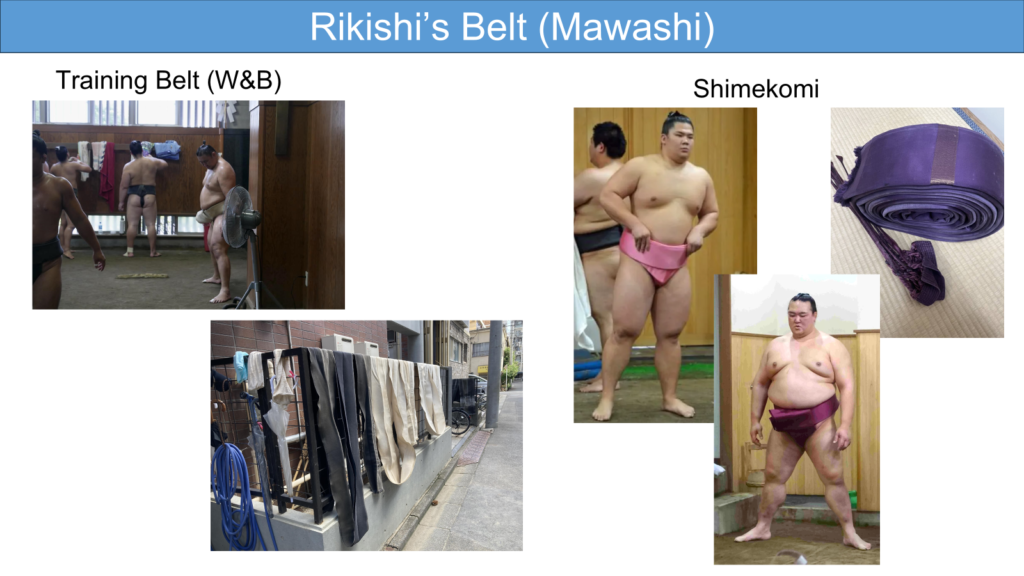
Sekitori, excluding Yokozuna, also wears the Kesho Mawashi for the Dohyo Iri ceremony. Yokozuna performs his own Dohyo Iri with Kesho Mawashi and Shimenawa, which is a holy rope only Yokozuna is allowed to put on. Shimenawa marks the boundary between the world of deities and ordinary people, as seen in shrines in Japan. The Shimenawa on Yokozuna’s waist shows that the deity of Sumo comes down on Yokozuna and resides in him during the Dohyo Iri.
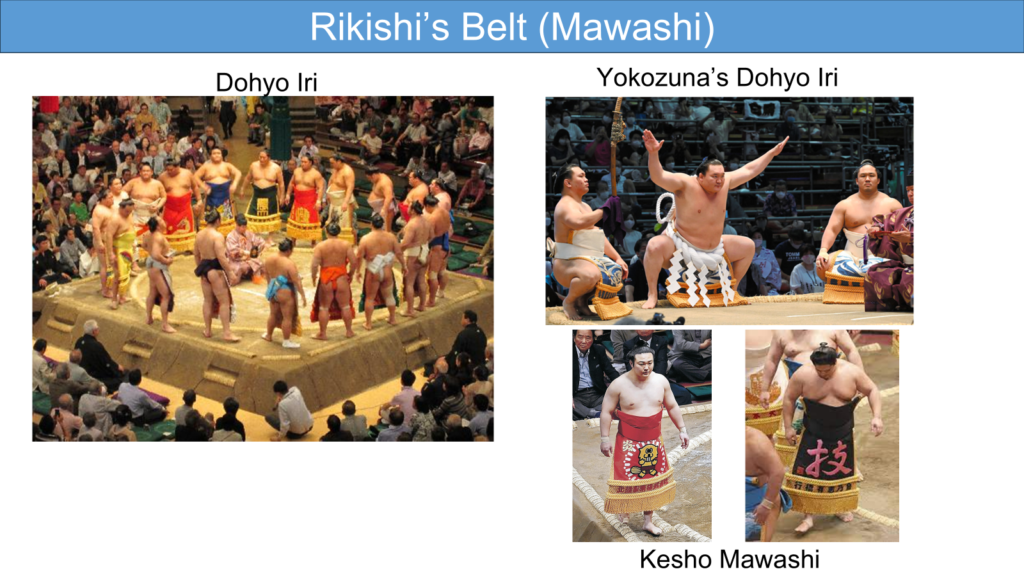
The Rikishi’s hairstyle is unique and reminds us that they used to be samurais. Sekitoris have their hair shaped in a Gingko-Leaf style called Oicho. Makushita Rikishi cannot wear the Gingko-Leaf style and put a simple hair topknot on their heads. Some young Rikishi do not have long enough hair to make a topknot, so they have just long hair until it grows to the necessary length.

Rikishis have a big meal twice a day called Chanko. Chan means “father” or “master” (Oyakata) in the Sumo world, and Ko means children or apprentices in this case. So the master and Rikishis share the same meal, Chanko, which works well for building a good relationship and trust. Still, there is a hierarchical system even in Chanko. Look at the photo on the top right. Oyakata (right) and Sekitori are enjoying Chanko, but Makushita, minor class Rikishis, are standing to serve them without eating anything yet. They can eat Chanko after Oyakata and Sekitori finish their meal.
The Chanko is cooked by the minor class Rikishi, and each Sumo Stable has its own recipe. Some Oyakatas never allow pork and beef in the Chanko because these animals put their front legs on the ground, which gives the impression that the Rikishi put their hands on the ground, meaning they lost the match.

Thank you for reading my blog post. If you are interested in visiting the sumo morning training, please get in touch with me via the “Contact me!” box below. I can take you to a sumo stable. It’s worth trying. All my guests who enjoyed the sumo morning training experience are 100% satisfied. I guarantee you!
Please click the links to get updated via my X (former Twitter) and Instagram.
X (former Twitter): https://x.com/ToruGuide
Instagram: https://www.instagram.com/toruhigaki/
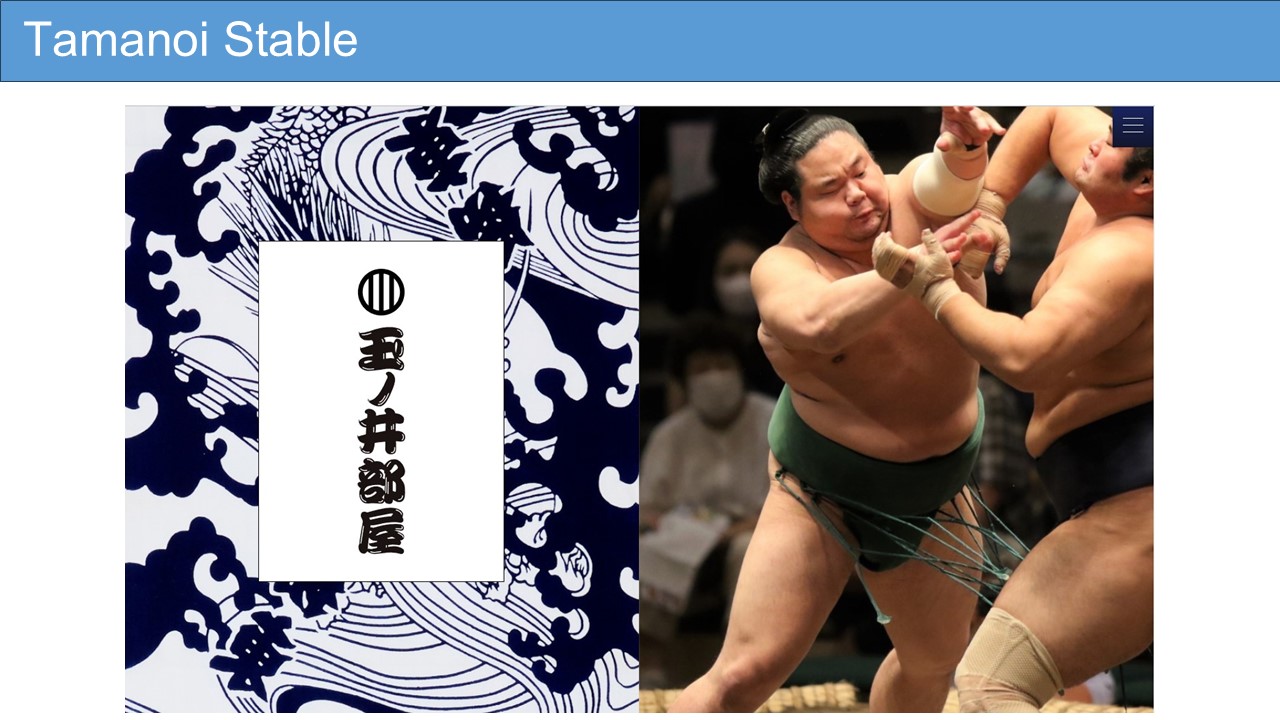


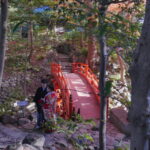
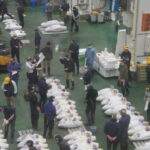
Comment